| Advanced Analytics
The Power Of Choice Modeling: MaxDiff Analysis
MaxDiff is the most popular choice modeling technique. It involves evaluating many smaller sets of product features, claims, or other attributes. For each small set, respondents select the most important item and the least important item that influence their purchase decision.
Advantages of this technique are that it works well with a variety of items, such as product features, ideas, claims, and benefits. And it is a simpler, more focused task for the respondent. Selecting the most and the least from small sets of items is much easier than rating each item on a 5-point importance scale.
What MaxDiff Can Do For You
MaxDiff is an experimental design that is tailored to the specific objectives, constraints, and variables of each project. Customization is the key to success because every category/brand has critical idiosyncrasies. The resulting data are used to create a simulator in which potential sets of marketing variables, product features, and advertising conditions can be evaluated. Below are 3 popular applications of MaxDiff in marketing research:
Ranking
MaxDiff can produce a relative ranking of product claims, positionings, flavors, product varieties, and so on. MaxDiff modeling produces a probability that each item will be selected as "most" from a set of items.

These probabilities are relative measures of the strength of preference or importance of each item. Higher numbers indicate higher preference, and lower numbers indicate lower preference. These preferences can be used to make comparisons, both within and between respondent groups.
Optimization
The results derived from the MaxDiff can be used to develop optimal combinations using a TURF-like optimization algorithm; that is, it can optimize sets of items.

The algorithm searches for the combination of items that reaches the most consumers. Companies can then use results like these to build optimal product lines and flavor lines, or they can even build optimal bundles of messages to use when marketing a product.
Segmentation
The MaxDiff survey task forces respondents to make a discriminating choice about which item is most preferred and which item is least preferred, and so makes it a useful tool in segmentation.

There’s no possibility to encounter scale bias, where ratings are bunched up at the top end or bottom end of the scale. These discriminating choices help differentiate potential segments. So, using MaxDiff preference scores as one of the inputs into a segmentation model is a great way to promote more distinct groups.
Other Uses For MaxDiff
- Analyze price sensitivity and estimate demand curves.
- Optimize strategic positioning and brand strategy.
- Improve product-line planning to maximize market share.
- Evaluate and optimize new product concepts.
- Improve promotional offers and predict consumer responses to them.
- Optimize advertising claims and messages.
- Improve package designs.
Summary
The overriding goal of MaxDiff is to create realistic “shopping” scenarios that properly represent the buying behavior that we are striving to model. Whenever possible, the choice options are presented virtually using shelf sets, online websites, apps, or other buying environments. This increased realism results in a better understanding of customers' purchasing behavior, which powers better business decisions.
Our Leadership Team
We Are Here To Help
Decision Analyst is a leading global marketing research and analytical consulting firm and a recognized leader in large multinational qualitative investigations.
We pride ourselves on delivering implications and recommendations based on facts, objective evidence, truth–so that our Clients can make informed and confident decisions to grow their businesses and their brands.
Newsletter
Signup to receive our Create Winning Strategies Newsletter
Newsletter
Signup to receive our Create Winning Strategies Newsletter







